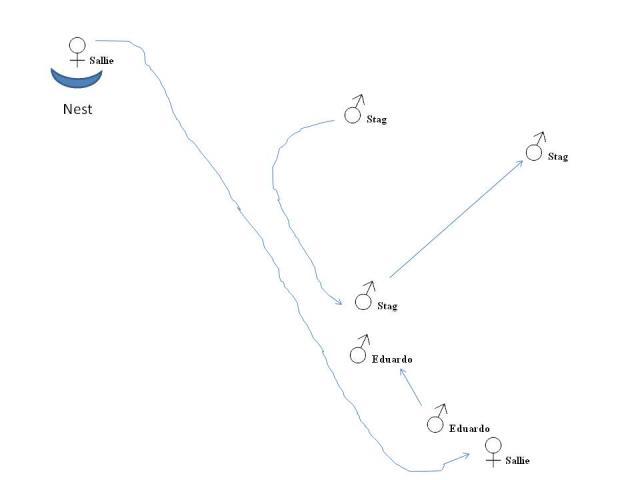- Thread starter
- #251
COCK BLOCKING
Interesting behavoir to note (See Diagram Below). Every time Sallie leaves nest she sneaks back in direction of flock. She makes the squawk produced after laying an egg, and is always covered by Eduardo when she returns. She solicits it each time. The satellite stags having no harem of their own try to entercept Sallie (and red jungle hen) before the females return to flock. Both hens can easily outfly the domininque cross stags but they seem easy catch while on ground. Neither hen seems to want the stags to cover them and Eduardo (cock) certainly does not like either. Sallie avoids by running, flying and moving towards Eduardo and going behind him so Eduardo is between her and pursuing stag. Eduardo steps into path of pursuing stag, faces off and puffs out his chest while holding tail high. Stag stops and rapidly turns away and if not quick enough Eduardo thumps him hard. Eduardo then turns around and Sallie solicits mating followed by Eduardo doing the deed. Arrangment I call "cock blocking" since the cock throws a block stopping advance of randy stag.

Sallie is attempting brood 4 despite being in full molt. Nest not found yet but I will be watching this weekend so it can be busted. Tadtkerson will incubate them as well. Hatch rate of brood 3 at Tadtkerson's less that 50%.
Interesting behavoir to note (See Diagram Below). Every time Sallie leaves nest she sneaks back in direction of flock. She makes the squawk produced after laying an egg, and is always covered by Eduardo when she returns. She solicits it each time. The satellite stags having no harem of their own try to entercept Sallie (and red jungle hen) before the females return to flock. Both hens can easily outfly the domininque cross stags but they seem easy catch while on ground. Neither hen seems to want the stags to cover them and Eduardo (cock) certainly does not like either. Sallie avoids by running, flying and moving towards Eduardo and going behind him so Eduardo is between her and pursuing stag. Eduardo steps into path of pursuing stag, faces off and puffs out his chest while holding tail high. Stag stops and rapidly turns away and if not quick enough Eduardo thumps him hard. Eduardo then turns around and Sallie solicits mating followed by Eduardo doing the deed. Arrangment I call "cock blocking" since the cock throws a block stopping advance of randy stag.

Sallie is attempting brood 4 despite being in full molt. Nest not found yet but I will be watching this weekend so it can be busted. Tadtkerson will incubate them as well. Hatch rate of brood 3 at Tadtkerson's less that 50%.



